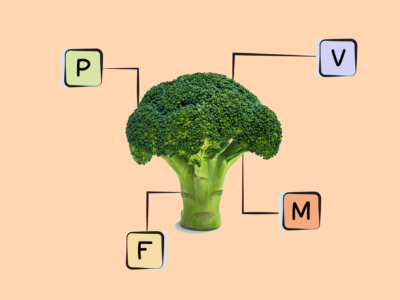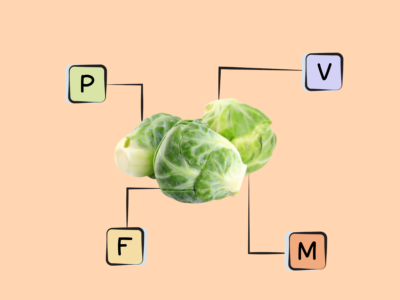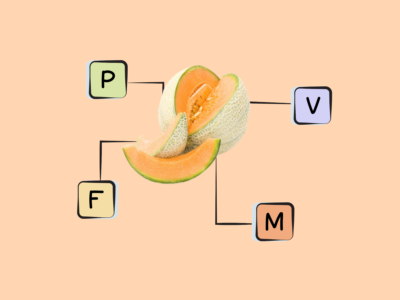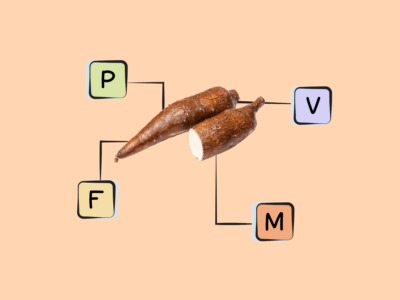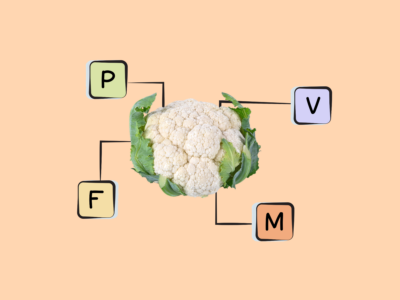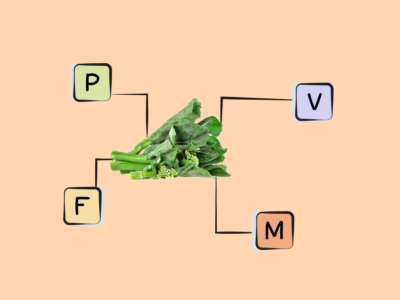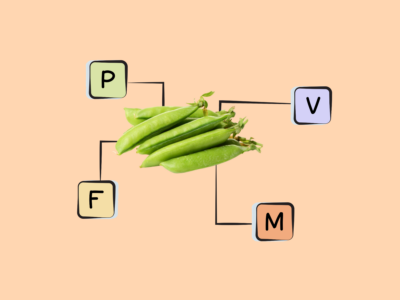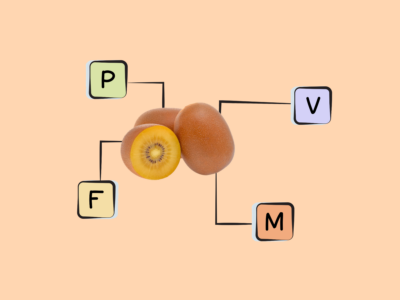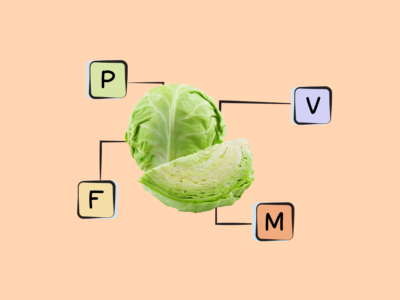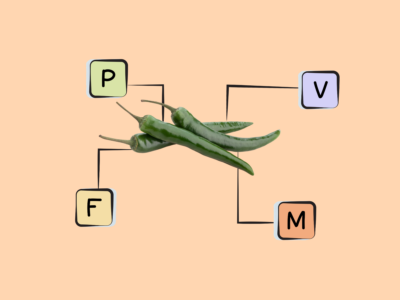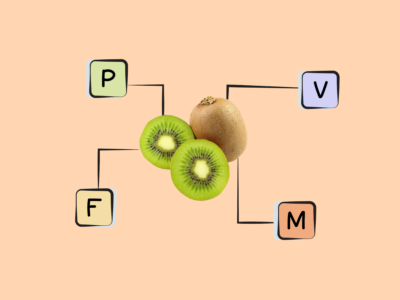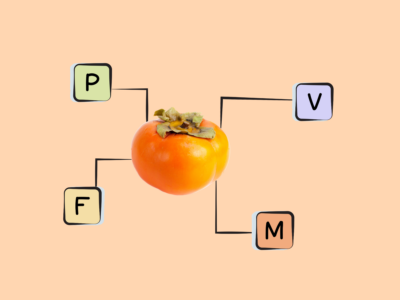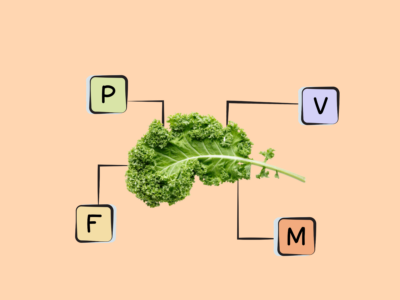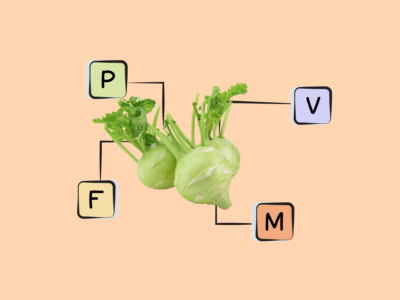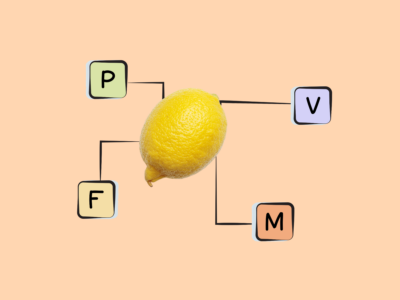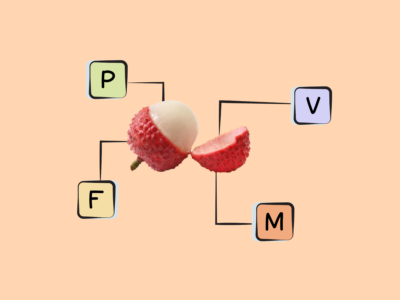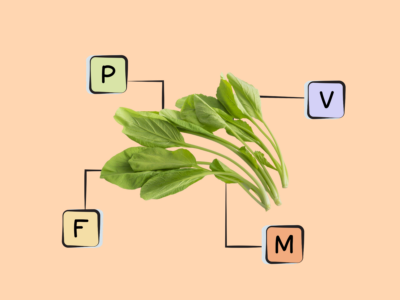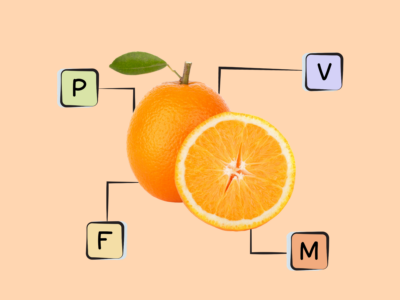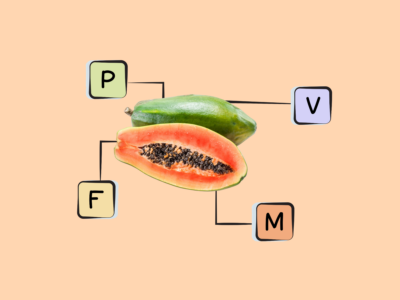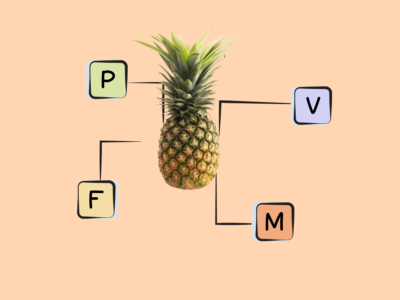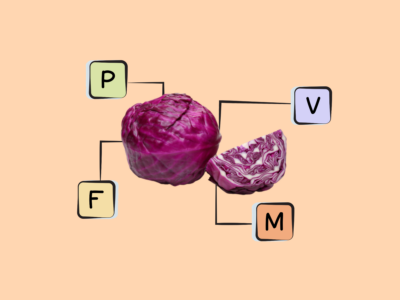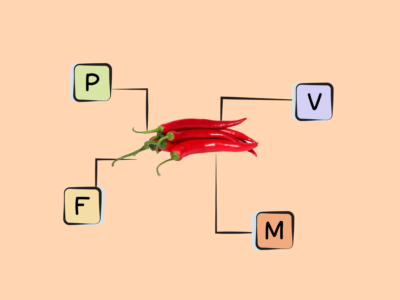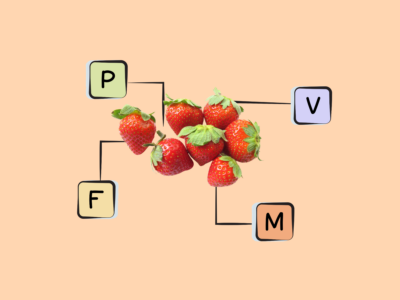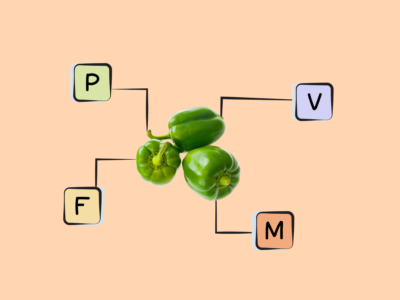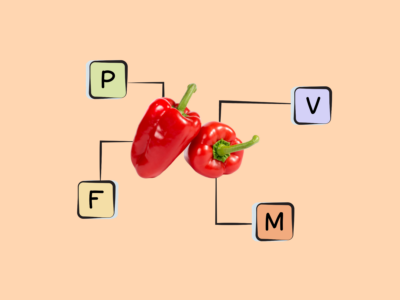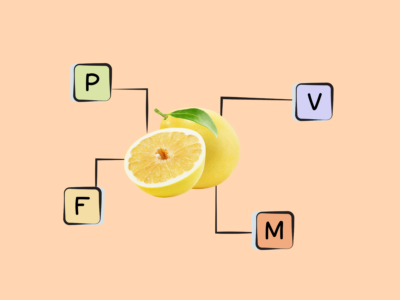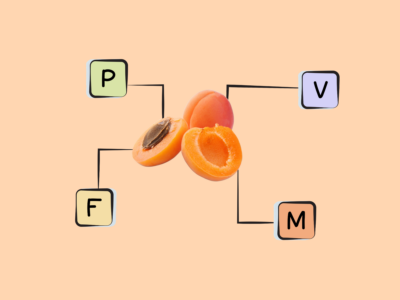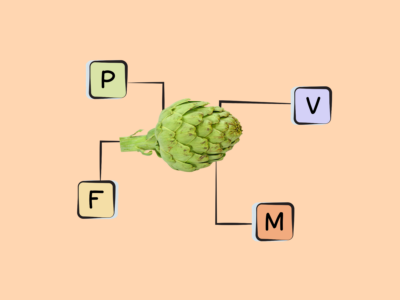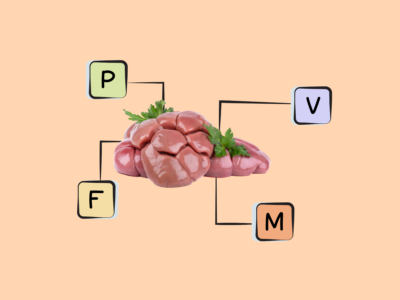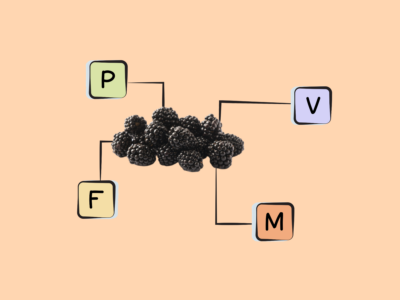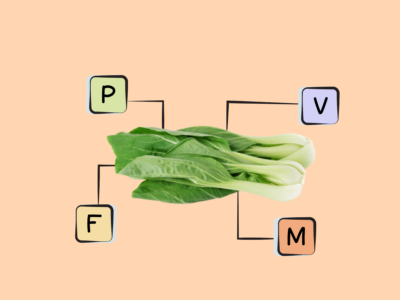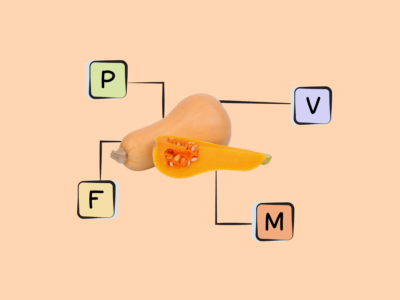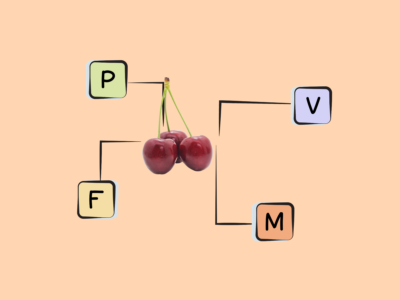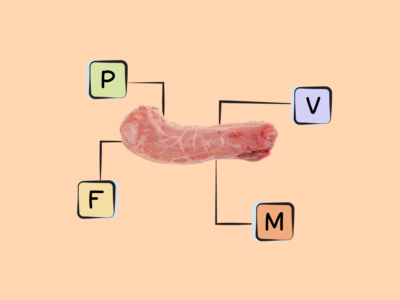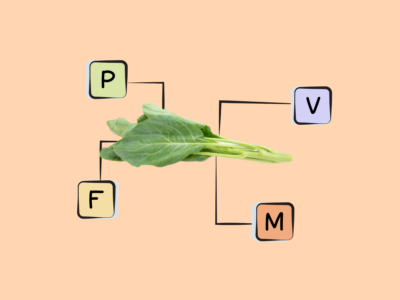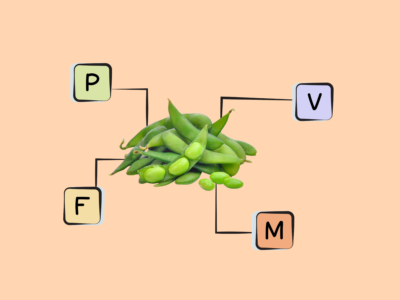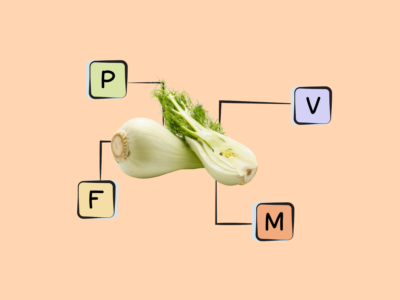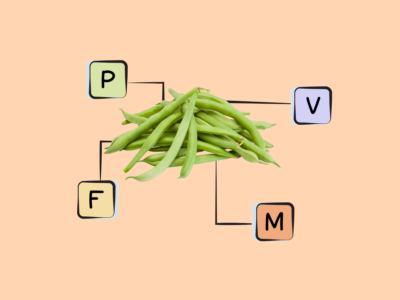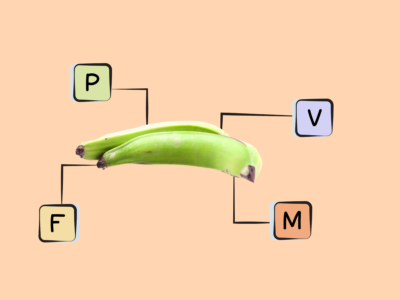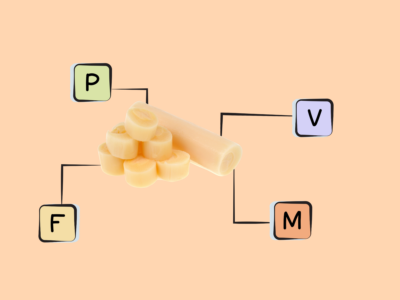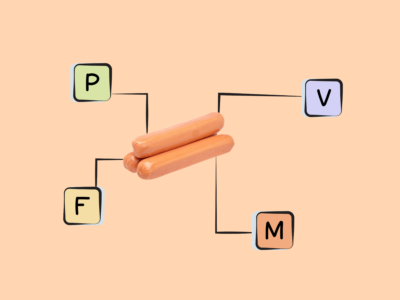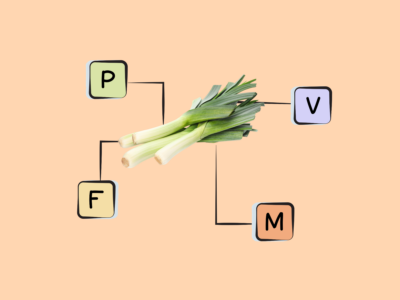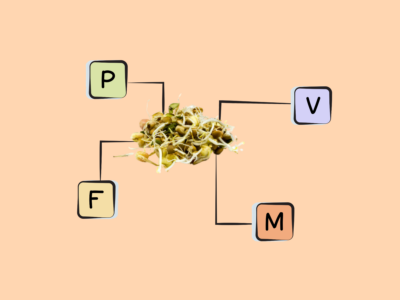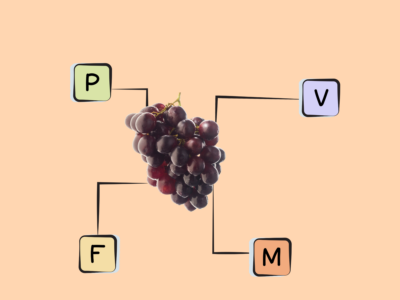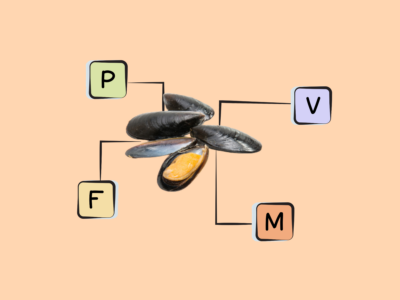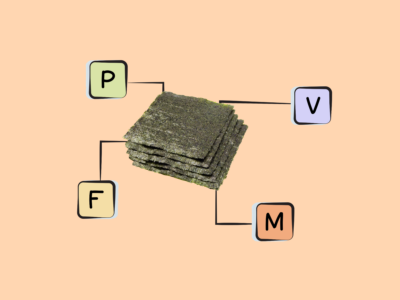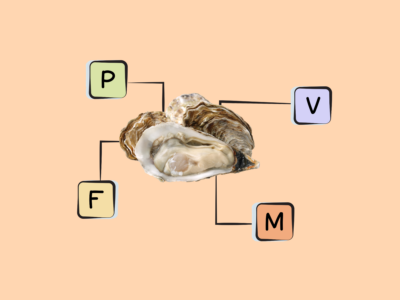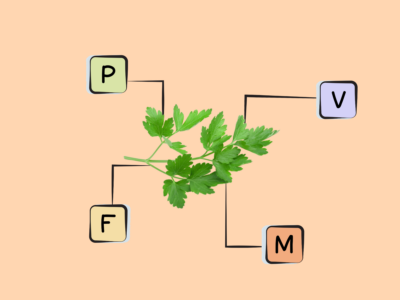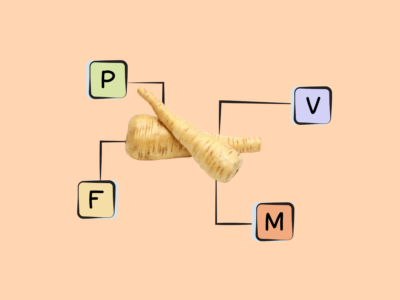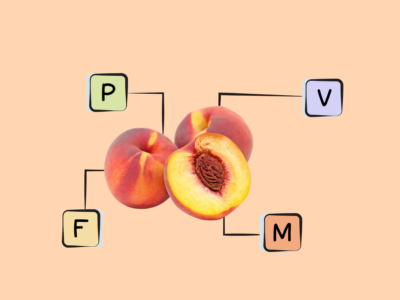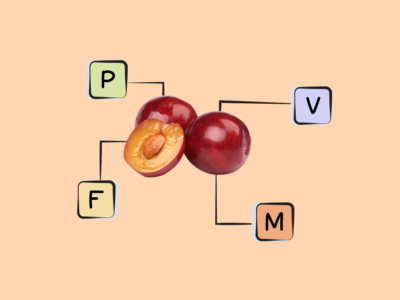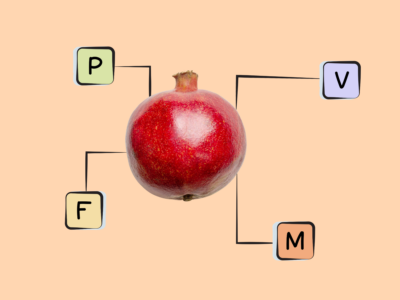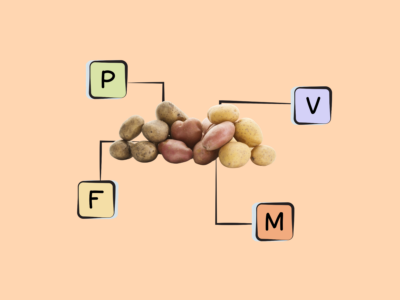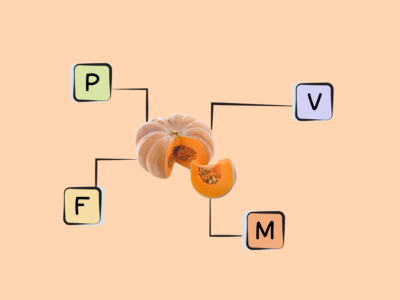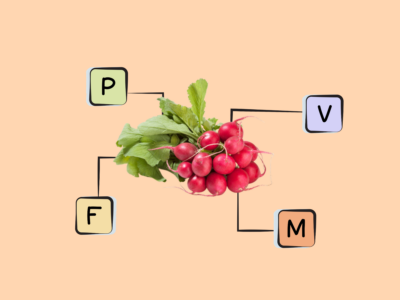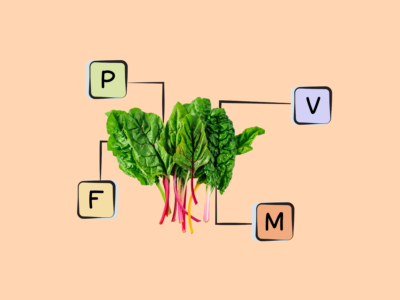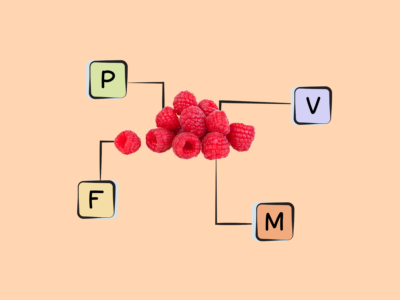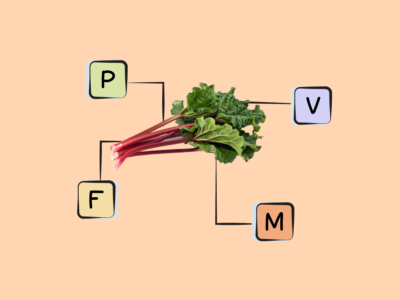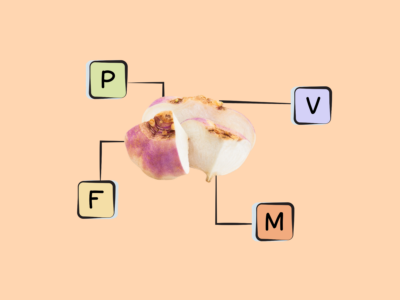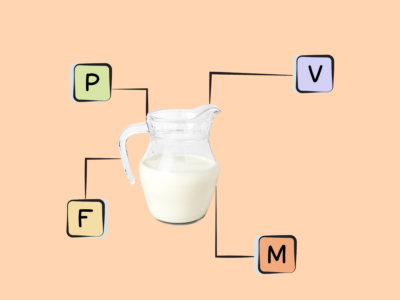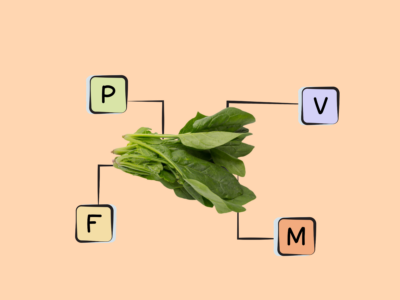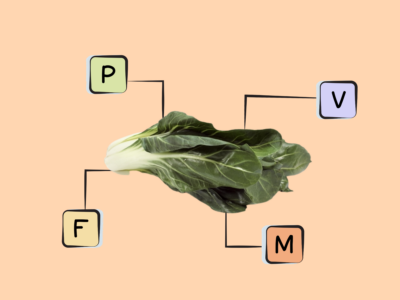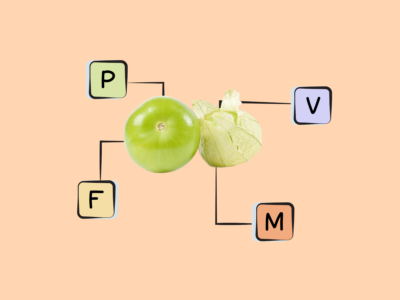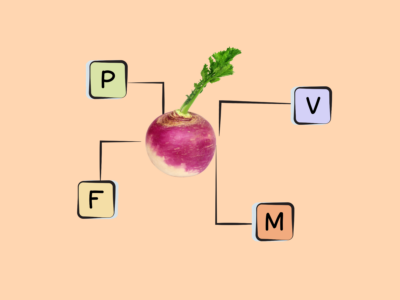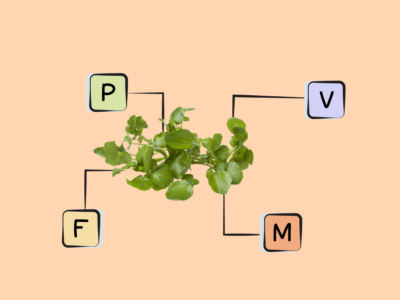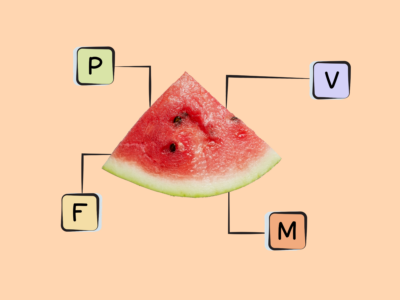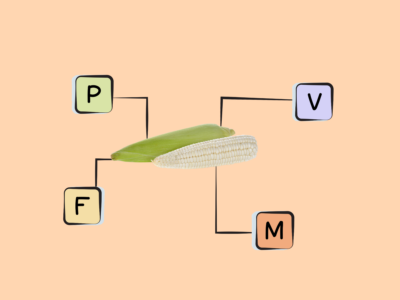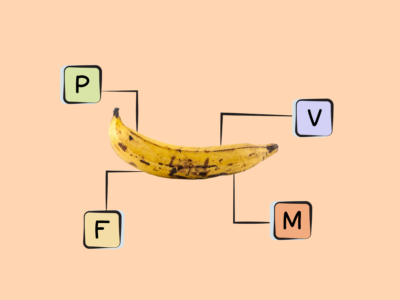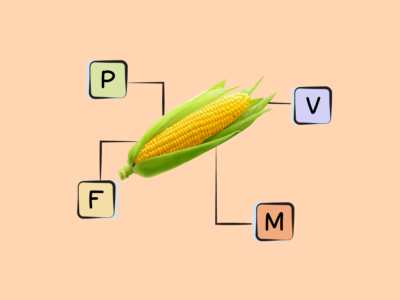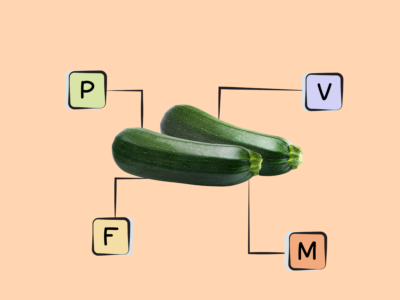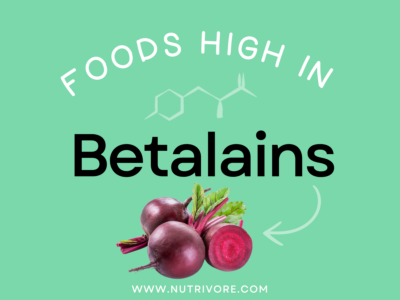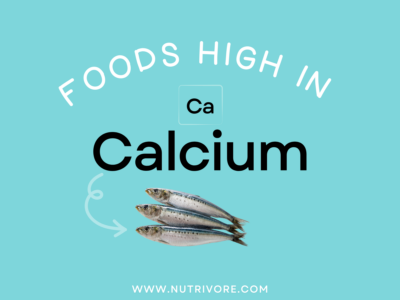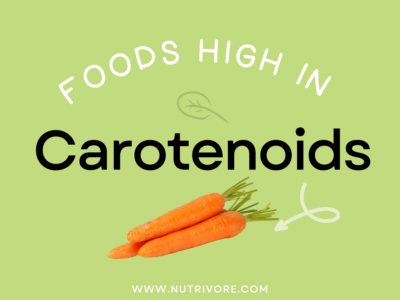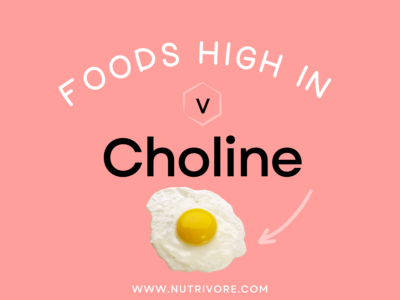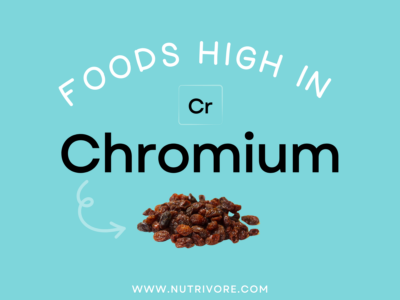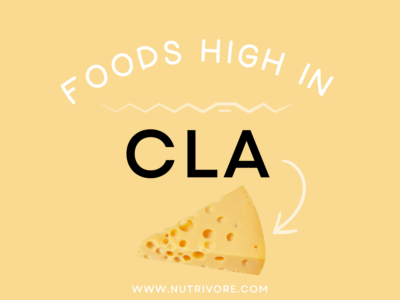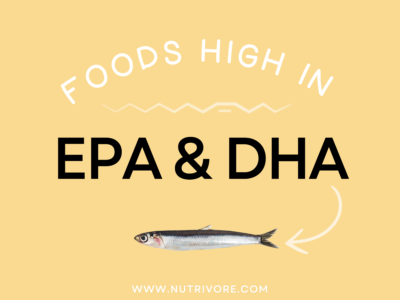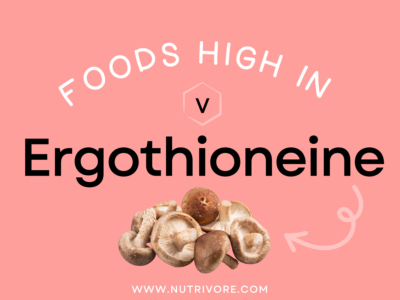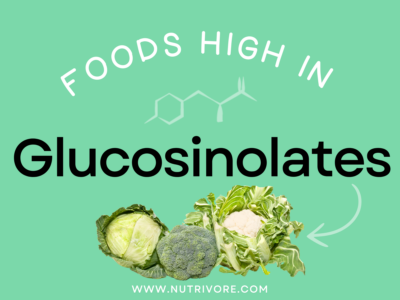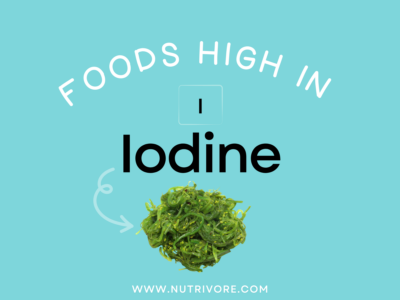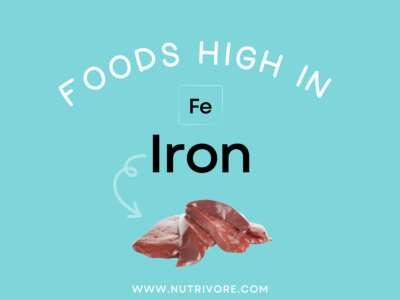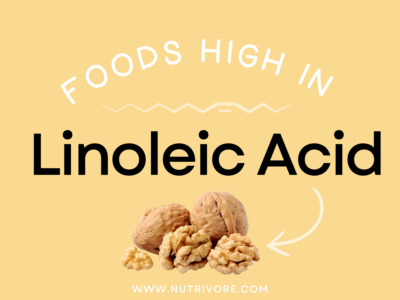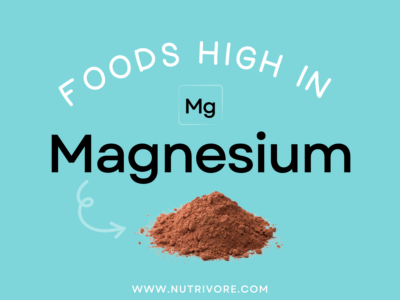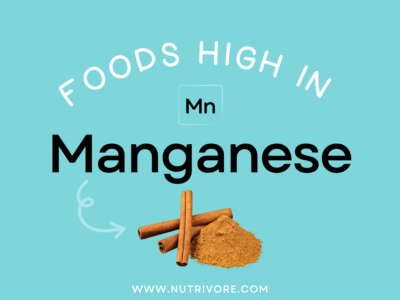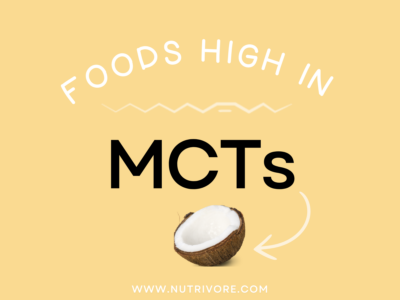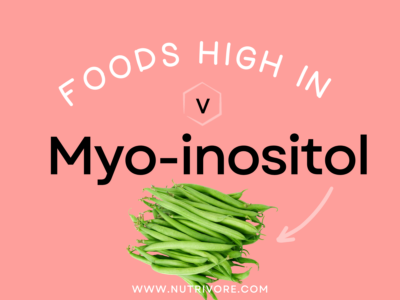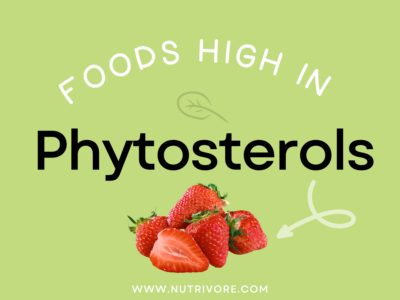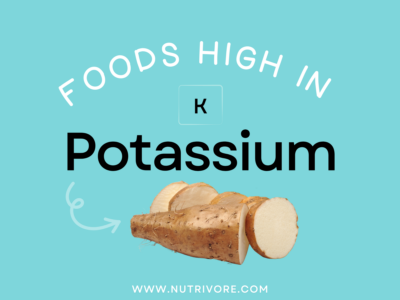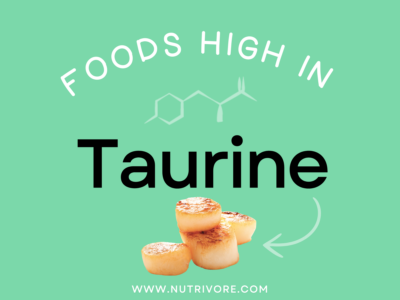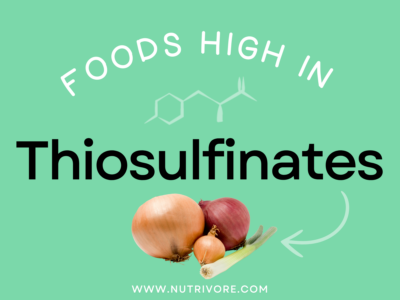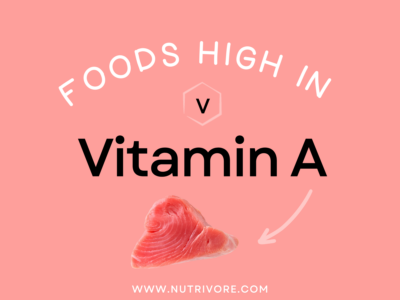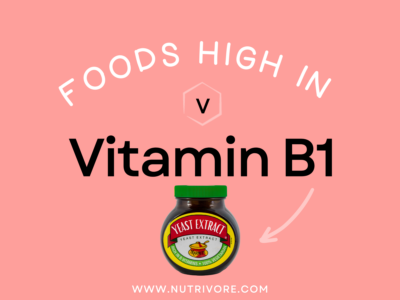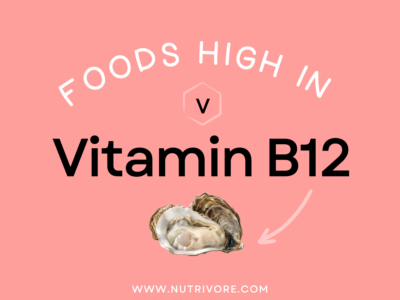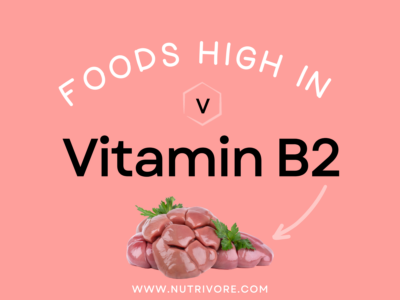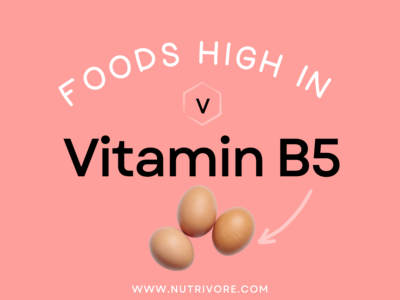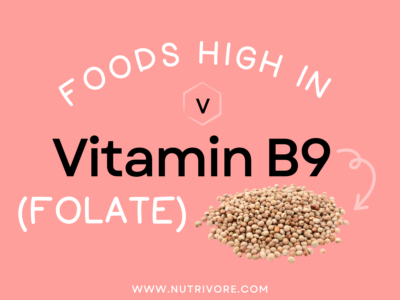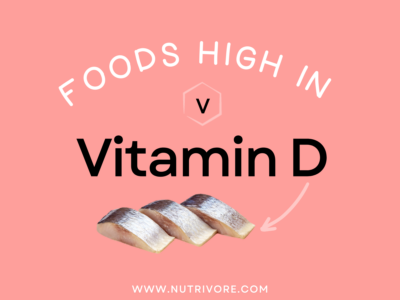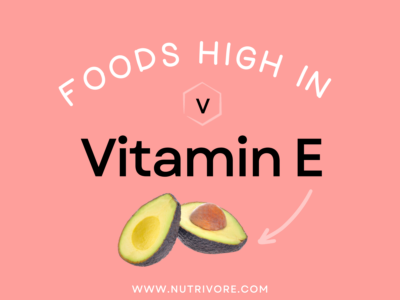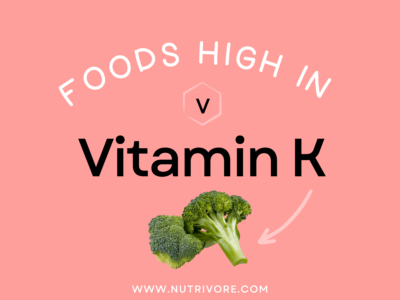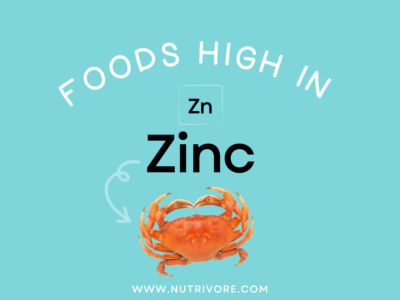Table of Contents[Hide][Show]
Top 5 Common Food Sources of Vitamin C
Looking to get more mg of vitamin C (aka ascorbic acid) in your diet? Look no further! My team and I have crunched the numbers and did all the math to determine the top 5 common food sources of vitamin C, per serving. (Spoiler alert – oranges and orange juice didn’t make the cut!) Getting enough vitamin C as part of a healthy balanced diet is important since a large collection of studies show that getting nutrients from dietary supplements doesn’t improve health outcomes compared to getting nutrients from foods! It’s also worth noting that vitamin C reaches maximum absorption (100%) when ingested at doses up to 200 mg at a time so it’s smart to spread vitamin C intake throughout the day instead of eating all your vitamin-C-rich foods (or vitamin C supplements or a multivitamin with a high dose of vitamin C) in one sitting! And, since vitamin C is a water-soluble vitamin, it doesn’t get stored internally which means we need to ingest it regularly.
| Rank | Food | Nutrivore Score | Serving Size (Raw) | Vitamin C (mg/serving) | % Daily Value |
|---|---|---|---|---|---|
| 1 | Guavas, Common | 761 | 1 cup | 376.7 | 419 |
| 2 | Kiwi, Average1 | 476 | 1 cup, sliced | 228.6 | 254 |
| 3 | Persimmons, Japanese | 537 | 1 cup, diced | 212.5 | 236 |
| 4 | Currants, European Black | 811 | 1 cup | 202.7 | 225 |
| 5 | Tomato Juice, Canned, w/o salt added | 1568 | 1 cup | 170.3 | 189 |
Want to know more about this important vitamin for our immune system including what vitamin C does in the body, how much vitamin C we need, what happens if we have low vitamin C levels or if we get too much, and even more awesome food sources of vitamin C? Keep reading to learn all there is to know!
Learn What Foods Are the Best Sources of Every Nutrient

The Top 25 Foods for Every Nutrient
The Top 25 Foods for Every Nutrient e-book is a well-organized, easy-to-use, grocery store-friendly guide to help you choose foods that fit your needs of 43 important nutrients while creating a balanced nutrient-dense diet.
Get two “Top 25” food lists for each nutrient, plus you’ll find RDA charts for everyone, informative visuals, fun facts, serving sizes and the 58 foods that are Nutrient Super Stars!
Buy now for instant digital access.
What Is Vitamin C and What Does It Do?
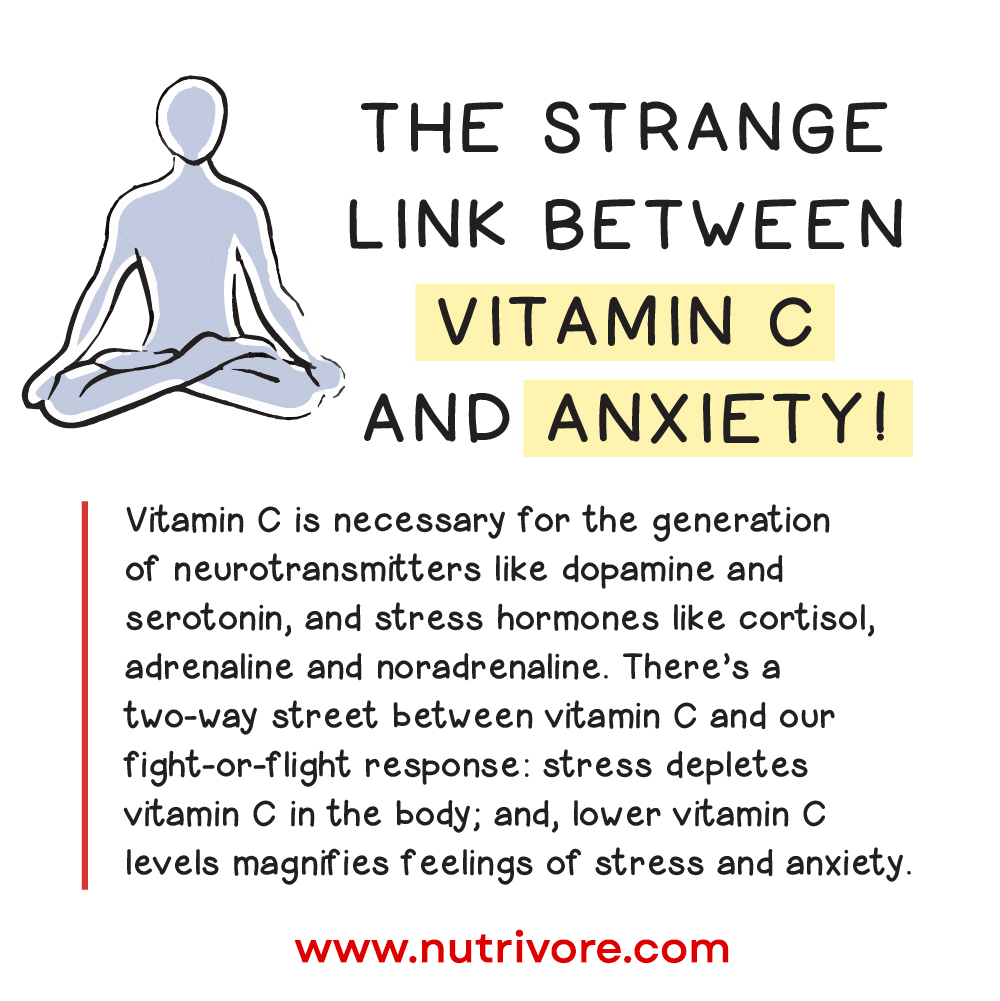
Vitamin C is an absolute rock star when it comes to our health! Vitamin C is a water-soluble vitamin with potent antioxidant activity: it’s vital for the protection of many molecules in the body (including proteins, lipids, carbohydrates, and the nucleic acids RNA and DNA) against oxidative stress, i.e., damage generated by free radicals and reactive oxygen species. Vitamin C is also involved in recycling other antioxidants, such as vitamin E (which vitamin C helps regenerate from its oxidized form), making it supportive of antioxidant status even beyond its own direct activity.
Vitamin C is also an essential cofactor for a number of enzymes — particularly those involved in collagen biosynthesis (which is essential for the health of our bones, joints, teeth, blood vessels, skin and eyes), carnitine biosynthesis, neuropeptide production, tyrosine metabolism, histone demethylation, and DNA demethylation. So, vitamin C is essential for the biological functions that rely on these enzymes, including wound healing, energy production (particularly, the transport of long-chain fatty acids into mitochondria, which carnitine plays a critical role in), the formation of neurotransmitters (including dopamine and serotonin), and the formation of catecholamines (including cortisol, epinephrine [adrenaline] and norepinephrine [noradrenaline], which is how vitamin C regulates the stress response).
Vitamin C is also involved in immunity through several avenues. In vitro, vitamin C has been shown to stimulate the production and function of white blood cells such as lymphocytes, phagocytes, and neutrophils; these cells also accumulate high levels of vitamin C as protection against oxidative damage, which is particularly important for phagocytes, since one of their roles is to release reactive oxygen species to kill pathogens (and therefore they need vitamin C to protect against self-inflicted damage!). Additionally, vitamin C stimulates cellular motility, phagocytosis (the cellular ingestion of bacteria and other particles), and chemotaxis (the chemically-stimulated movement of cells towards more beneficial environments). And, vitamin C can enhance the capacity of neutrophils to kill microbes while also stimulating the proliferation and differentiation of T- and B-lymphocytes.
Higher intakes of vitamin C are linked to lower risk of heart disease, some forms of cancer, type 2 diabetes, cataracts, age-related macular degeneration, and gout. Vitamin C can also help regulate the stress response, thereby reducing risk for depression and anxiety; and, there’s preliminary evidence that it may also help prevent Alzheimer’s disease.
Learn more about vitamin C here.
Vitamin C Deficiency
A 2011 study evaluated American’s usual nutrient intake including nutrients that are naturally-occurring in foods, from fortified and enriched foods, and from supplements. The results indicated that 52.0% of American adults usual diet falls short of the Estimated Average Requirement (EAR) for vitamin C intake.
Groups At Risk
Those at high risk of vitamin C deficiency include:
- people with genetic polymorphisms affecting vitamin C transport,
- those with health conditions that reduce vitamin C absorption, such as kidney disease,
- smokers and those who consume alcohol regularly, and
- people with increased vitamin C needs due to hyperthyroidism, iron deficiency, surgery, burns, inflammation, fever, diarrhea, and cold or heat stress.
Learn more here.
Symptoms of Deficiency
Severe vitamin C deficiency, known as scurvy, impairs collagen production, leading to tissue breakdown and symptoms like bleeding, poor wound healing, easy bruising, joint pain, and disintegration of the connective tissues in the gums, eventually causing tooth loss. General deficiency symptoms include fatigue, weakness, irritability, weight loss, joint and muscle pain, slow wound healing, anemia, depression, and bleeding gums to name a few. These symptoms develop over weeks or months of low vitamin C levels, though there’s limited evidence linking deficiency to chronic disease risk.
Learn more here.
Problems From Too Much Vitamin C
Daily intake above 2000 mg could lead to gastrointestinal upset. In some cases, dietary supplements that contain high doses of vitamin C can also cause headache, sleeping difficulties, skin flushing, and an increased risk of kidney stones, particularly in men.
How Much Vitamin C Do We Need?
The following table summarizes the current recommended amounts of vitamin C, based on age, gender, or situation but if you are stressed, have an infection, have an inflammatory condition, or are a smoker, you need even more vitamin C.
It’s also important to note that vitamin C has some interactions with other nutrients such as increasing non-heme iron absorption.
| 0 – 6 months | |||||
| 6 months to < 12 months | |||||
| 1 yr – 3 yrs | |||||
| 4 yrs – 8 yrs | |||||
| 9 yrs – 13 yrs | |||||
| 14 yrs – 18 yrs | |||||
| 19 yrs – 50 yrs | |||||
| 51+ yrs | |||||
| Pregnant (14 – 18 yrs) | |||||
| Pregnant (19 – 30 yrs) | |||||
| Pregnant (31 – 50 yrs) | |||||
| Lactating (14 – 18 yrs) | |||||
| Lactating (19 – 30 yrs) | |||||
| Lactating (31 – 50 yrs) |
Nutrient Daily Values
Nutrition requirements and recommended nutrient intake for infants, children, adolescents, adults, mature adults, and pregnant and lactating individuals.
More Food Sources of Vitamin C
The foods with the highest vitamin C content include: citrus fruits (oranges, grapefruit, lemons, limes), kiwifruit, berries, bell peppers, guavas, papayas, broccoli, Brussels sprouts, tomatoes, cantaloupe, and leafy greens. Some organ meats (adrenal glands in particular) are also good sources of vitamin C. Cooking can reduce vitamin C levels in foods, with boiling being the worst offender, due to this vitamin being both water-soluble and sensitive to heat; steaming and microwaving lead to the highest vitamin C retention. Prolonged storage, too, causes vitamin C levels in foods to diminish over time.
Best Food Sources of Vitamin C
The following foods are best sources of this essential nutrient, containing at least 50% of the recommended dietary allowance per serving!
Good Food Sources of Vitamin C
The following foods are also excellent or good sources of vitamin C, containing at least 10% (and up to 50%) of the daily value per serving.
Top 5 Common Food Sources
If you’re looking for top 5 common food sources of other important nutrients check out these posts!
cITATIONS
Expand to see all scientific references for this article.
Afkhami-Ardekani M, Shojaoddiny-Ardekani A. Effect of vitamin C on blood glucose, serum lipids & serum insulin in type 2 diabetes patients. Indian J Med Res. 2007 Nov;126(5):471-4.
Akmal M, Qadri JQ, Al-Waili NS, Thangal S, Haq A, Saloom KY. Improvement in human semen quality after oral supplementation of vitamin C. J Med Food. 2006 Fall;9(3):440-2. doi: 10.1089/jmf.2006.9.440.
Ashor AW, Lara J, Mathers JC, Siervo M. Effect of vitamin C on endothelial function in health and disease: a systematic review and meta-analysis of randomised controlled trials. Atherosclerosis. 2014 Jul;235(1):9-20. doi: 10.1016/j.atherosclerosis.2014.04.004.
Ashor AW, Werner AD, Lara J, Willis ND, Mathers JC, Siervo M. Effects of vitamin C supplementation on glycaemic control: a systematic review and meta-analysis of randomised controlled trials. Eur J Clin Nutr. 2017 Dec;71(12):1371-1380. doi: 10.1038/ejcn.2017.24.
Aune D, Keum N, Giovannucci E, Fadnes LT, Boffetta P, Greenwood DC, Tonstad S, Vatten LJ, Riboli E, Norat T. Dietary intake and blood concentrations of antioxidants and the risk of cardiovascular disease, total cancer, and all-cause mortality: a systematic review and dose-response meta-analysis of prospective studies. Am J Clin Nutr. 2018 Nov 1;108(5):1069-1091. doi: 10.1093/ajcn/nqy097.
Bernardo D, Martínez-Abad B, Vallejo-Diez S, Montalvillo E, Benito V, Anta B, Fernández-Salazar L, Blanco-Quirós A, Garrote JA, Arranz E. Ascorbate-dependent decrease of the mucosal immune inflammatory response to gliadin in coeliac disease patients. Allergol Immunopathol (Madr). 2012 Jan-Feb;40(1):3-8. doi: 10.1016/j.aller.2010.11.003.
Bowman GL. Ascorbic acid, cognitive function, and Alzheimer’s disease: a current review and future direction. Biofactors. 2012 Mar-Apr;38(2):114-22. doi: 10.1002/biof.1002.
Brody S, Preut R, Schommer K, Schürmeyer TH. A randomized controlled trial of high dose ascorbic acid for reduction of blood pressure, cortisol, and subjective responses to psychological stress. Psychopharmacology (Berl). 2002 Jan;159(3):319-24. doi: 10.1007/s00213-001-0929-6.
Carr AC, Frei B. Toward a new recommended dietary allowance for vitamin C based on antioxidant and health effects in humans. Am J Clin Nutr. 1999 Jun;69(6):1086-107. doi: 10.1093/ajcn/69.6.1086.
Carr AC, Lunt H, Wareham NJ, Myint PK. Estimating Vitamin C Intake Requirements in Diabetes Mellitus: Analysis of NHANES 2017-2018 and EPIC-Norfolk Cohorts. Antioxidants (Basel). 2023 Oct 15;12(10):1863. doi: 10.3390/antiox12101863.
Carr AC, Maggini S. Vitamin C and Immune Function. Nutrients. 2017 Nov 3;9(11):1211. doi: 10.3390/nu9111211.
Carr AC, Rosengrave PC, Bayer S, Chambers S, Mehrtens J, Shaw GM. Hypovitaminosis C and vitamin C deficiency in critically ill patients despite recommended enteral and parenteral intakes. Crit Care. 2017 Dec 11;21(1):300. doi: 10.1186/s13054-017-1891-y.
Chambial S, Dwivedi S, Shukla KK, John PJ, Sharma P. Vitamin C in disease prevention and cure: an overview. Indian J Clin Biochem. 2013 Oct;28(4):314-28. doi: 10.1007/s12291-013-0375-3.
Chen GC, Lu DB, Pang Z, Liu QF. Vitamin C intake, circulating vitamin C and risk of stroke: a meta-analysis of prospective studies. J Am Heart Assoc. 2013 Nov 27;2(6):e000329. doi: 10.1161/JAHA.113.000329.
Chen Q, Espey MG, Krishna MC, Mitchell JB, Corpe CP, Buettner GR, Shacter E, Levine M. Pharmacologic ascorbic acid concentrations selectively kill cancer cells: action as a pro-drug to deliver hydrogen peroxide to tissues. Proc Natl Acad Sci U S A. 2005 Sep 20;102(38):13604-9. doi: 10.1073/pnas.0506390102.
Chen Z, Huang Y, Cao D, Qiu S, Chen B, Li J, Bao Y, Wei Q, Han P, Liu L. Vitamin C Intake and Cancers: An Umbrella Review. Front Nutr. 2022 Jan 20;8:812394. doi: 10.3389/fnut.2021.812394.
Choi HK, Gao X, Curhan G. Vitamin C intake and the risk of gout in men: a prospective study. Arch Intern Med. 2009 Mar 9;169(5):502-7. doi: 10.1001/archinternmed.2008.606.
Collins BJ, Mukherjee MS, Miller MD, Delaney CL. Effect of Dietary or Supplemental Vitamin C Intake on Vitamin C Levels in Patients with and without Cardiovascular Disease: A Systematic Review. Nutrients. 2021 Jul 8;13(7):2330. doi: 10.3390/nu13072330.
Dawson EB, Evans DR, Harris WA, Teter MC, McGanity WJ. The effect of ascorbic acid supplementation on the blood lead levels of smokers. J Am Coll Nutr. 1999 Apr;18(2):166-70. doi: 10.1080/07315724.1999.10718845.
Edefonti V, Hashibe M, Parpinel M, Turati F, Serraino D, Matsuo K, Olshan AF, Zevallos JP, Winn DM, Moysich K, Zhang ZF, Morgenstern H, Levi F, Kelsey K, McClean M, Bosetti C, Galeone C, Schantz S, Yu GP, Boffetta P, Amy Lee YC, Chuang SC, La Vecchia C, Decarli A. Natural vitamin C intake and the risk of head and neck cancer: A pooled analysis in the International Head and Neck Cancer Epidemiology Consortium. Int J Cancer. 2015 Jul 15;137(2):448-62. doi: 10.1002/ijc.29388.
Evans JR, Lawrenson JG. Antioxidant vitamin and mineral supplements for slowing the progression of age-related macular degeneration. Cochrane Database Syst Rev. 2023 Sep 13;9(9):CD000254. doi: 10.1002/14651858.CD000254.pub5.
Eydou Z, Jad BN, Elsayed Z, Ismail A, Magaogao M, Hossain A. Investigation on the effect of vitamin C on growth & biofilm-forming potential of Streptococcus mutans isolated from patients with dental caries. BMC Microbiol. 2020 Jul 30;20(1):231. doi: 10.1186/s12866-020-01914-4.
Farhadnejad H, Asghari G, Mirmiran P, Yuzbashian E, Azizi F. Micronutrient Intakes and Incidence of Chronic Kidney Disease in Adults: Tehran Lipid and Glucose Study. Nutrients. 2016 Apr 20;8(4):217. doi: 10.3390/nu8040217.
Food and Nutrition Board, Institute of Medicine. Vitamin C. Dietary Reference Intakes for Vitamin C, Vitamin E, Selenium, and Carotenoids. Washington, D.C.: National Academy Press; 2000:95-185.
Frei B, Birlouez-Aragon I, Lykkesfeldt J. Authors’ perspective: What is the optimum intake of vitamin C in humans? Crit Rev Food Sci Nutr. 2012;52(9):815-29. doi: 10.1080/10408398.2011.649149.
Fulgoni VL 3rd, Keast DR, Bailey RL, Dwyer J. Foods, fortificants, and supplements: Where do Americans get their nutrients? J Nutr. 2011 Oct;141(10):1847-54. doi: 10.3945/jn.111.142257. Epub 2011 Aug 24. PMID: 21865568; PMCID: PMC3174857.
Gao X, Curhan G, Forman JP, Ascherio A, Choi HK. Vitamin C intake and serum uric acid concentration in men. J Rheumatol. 2008 Sep;35(9):1853-8.
Gillani SW, Sulaiman SAS, Abdul MIM, Baig MR. Combined effect of metformin with ascorbic acid versus acetyl salicylic acid on diabetes-related cardiovascular complication; a 12-month single blind multicenter randomized control trial. Cardiovasc Diabetol. 2017 Aug 14;16(1):103. doi: 10.1186/s12933-017-0584-9.
Hamid M, Mansoor S, Amber S, Zahid S. A quantitative meta-analysis of vitamin C in the pathophysiology of Alzheimer’s disease. Front Aging Neurosci. 2022 Sep 7;14:970263. doi: 10.3389/fnagi.2022.970263.
Hansen SN, Tveden-Nyborg P, Lykkesfeldt J. Does vitamin C deficiency affect cognitive development and function? Nutrients. 2014 Sep 19;6(9):3818-46. doi: 10.3390/nu6093818.
Hantikainen E, Trolle Lagerros Y, Ye W, Serafini M, Adami HO, Bellocco R, Bonn S. Dietary Antioxidants and the Risk of Parkinson Disease: The Swedish National March Cohort. Neurology. 2021 Feb 9;96(6):e895-e903. doi: 10.1212/WNL.0000000000011373.
Harding AH, Wareham NJ, Bingham SA, Khaw K, Luben R, Welch A, Forouhi NG. Plasma vitamin C level, fruit and vegetable consumption, and the risk of new-onset type 2 diabetes mellitus: the European prospective investigation of cancer–Norfolk prospective study. Arch Intern Med. 2008 Jul 28;168(14):1493-9. doi: 10.1001/archinte.168.
Hemilä H. Vitamin C and common cold-induced asthma: a systematic review and statistical analysis. Allergy Asthma Clin Immunol. 2013 Nov 26;9(1):46. doi: 10.1186/1710-1492-9-46.
Hemilä H, Chalker E. Vitamin C reduces the severity of common colds: a meta-analysis. BMC Public Health. 2023 Dec 11;23(1):2468. doi: 10.1186/s12889-023-17229-8.
Hornung TC, Biesalski HK. Glut-1 explains the evolutionary advantage of the loss of endogenous vitamin C-synthesis: The electron transfer hypothesis. Evol Med Public Health. 2019 Aug 28;2019(1):221-231. doi: 10.1093/emph/eoz024.
Hu X, Yuan L, Wang H, Li C, Cai J, Hu Y, Ma C. Efficacy and safety of vitamin C for atrial fibrillation after cardiac surgery: A meta-analysis with trial sequential analysis of randomized controlled trials. Int J Surg. 2017 Jan;37:58-64. doi: 10.1016/j.ijsu.2016.12.009.
Huck CJ, Johnston CS, Beezhold BL, Swan PD. Vitamin C status and perception of effort during exercise in obese adults adhering to a calorie-reduced diet. Nutrition. 2013 Jan;29(1):42-5. doi: 10.1016/j.nut.2012.01.021.
Jang W, Kim H, Lee BE, Chang N. Maternal fruit and vegetable or vitamin C consumption during pregnancy is associated with fetal growth and infant growth up to 6 months: results from the Korean Mothers and Children’s Environmental Health (MOCEH) cohort study. Nutr J. 2018 Nov 12;17(1):105. doi: 10.1186/s12937-018-0410-6.
Jayedi A, Rashidy-Pour A, Parohan M, Zargar MS, Shab-Bidar S. Dietary and circulating vitamin C, vitamin E, β-carotene and risk of total cardiovascular mortality: a systematic review and dose-response meta-analysis of prospective observational studies. Public Health Nutr. 2019 Jul;22(10):1872-1887. doi: 10.1017/S1368980018003725.
Jenab M, Riboli E, Ferrari P, Sabate J, Slimani N, Norat T, Friesen M, Tjønneland A, Olsen A, Overvad K, Boutron-Ruault MC, Clavel-Chapelon F, Touvier M, Boeing H, Schulz M, Linseisen J, Nagel G, Trichopoulou A, Naska A, Oikonomou E, Krogh V, Panico S, Masala G, Sacerdote C, Tumino R, Peeters PH, Numans ME, Bueno-de-Mesquita HB, Büchner FL, Lund E, Pera G, Sanchez CN, Sánchez MJ, Arriola L, Barricarte A, Quirós JR, Hallmans G, Stenling R, Berglund G, Bingham S, Khaw KT, Key T, Allen N, Carneiro F, Mahlke U, Del Giudice G, Palli D, Kaaks R, Gonzalez CA. Plasma and dietary vitamin C levels and risk of gastric cancer in the European Prospective Investigation into Cancer and Nutrition (EPIC-EURGAST). Carcinogenesis. 2006 Nov;27(11):2250-7. doi: 10.1093/carcin/bgl096.
Juhl B, Lauszus FF, Lykkesfeldt J. Poor Vitamin C Status Late in Pregnancy Is Associated with Increased Risk of Complications in Type 1 Diabetic Women: A Cross-Sectional Study. Nutrients. 2017 Feb 23;9(3):186. doi: 10.3390/nu9030186.
Juraschek SP, Gaziano JM, Glynn RJ, Gomelskaya N, Bubes VY, Buring JE, Shmerling RH, Sesso HD. Effects of vitamin C supplementation on gout risk: results from the Physicians’ Health Study II trial. Am J Clin Nutr. 2022 Sep 2;116(3):812-819. doi: 10.1093/ajcn/nqac140.
Juraschek SP, Guallar E, Appel LJ, Miller ER 3rd. Effects of vitamin C supplementation on blood pressure: a meta-analysis of randomized controlled trials. Am J Clin Nutr. 2012 May;95(5):1079-88. doi: 10.3945/ajcn.111.027995.
Kabat GC, Kim MY, Wactawski-Wende J, Shikany JM, Vitolins MZ, Rohan TE. Intake of antioxidant nutrients and risk of non-Hodgkin’s Lymphoma in the Women’s Health Initiative. Nutr Cancer. 2012;64(2):245-54. doi: 10.1080/01635581.2012.642454.
Khaw KT, Bingham S, Welch A, Luben R, Wareham N, Oakes S, Day N. Relation between plasma ascorbic acid and mortality in men and women in EPIC-Norfolk prospective study: a prospective population study. European Prospective Investigation into Cancer and Nutrition. Lancet. 2001 Mar 3;357(9257):657-63. doi: 10.1016/s0140-6736(00)04128-3.
Knekt P, Ritz J, Pereira MA, O’Reilly EJ, Augustsson K, Fraser GE, Goldbourt U, Heitmann BL, Hallmans G, Liu S, Pietinen P, Spiegelman D, Stevens J, Virtamo J, Willett WC, Rimm EB, Ascherio A. Antioxidant vitamins and coronary heart disease risk: a pooled analysis of 9 cohorts. Am J Clin Nutr. 2004 Dec;80(6):1508-20. doi: 10.1093/ajcn/80.6.1508.
Kubota Y, Iso H, Date C, Kikuchi S, Watanabe Y, Wada Y, Inaba Y, Tamakoshi A; JACC Study Group. Dietary intakes of antioxidant vitamins and mortality from cardiovascular disease: the Japan Collaborative Cohort Study (JACC) study. Stroke. 2011 Jun;42(6):1665-72. doi: 10.1161/STROKEAHA.110.601526.
Levine M, Wang Y, Padayatty SJ, Morrow J. A new recommended dietary allowance of vitamin C for healthy young women. Proc Natl Acad Sci U S A. 2001 Aug 14;98(17):9842-6. doi: 10.1073/pnas.171318198.
Liu XX, Wang XX, Cui LL. Association between Oral vitamin C supplementation and serum uric acid: A meta-analysis of randomized controlled trials. Complement Ther Med. 2021 Aug;60:102761. doi: 10.1016/j.ctim.2021.102761.
Lykkesfeldt J, Christen S, Wallock LM, Chang HH, Jacob RA, Ames BN. Ascorbate is depleted by smoking and repleted by moderate supplementation: a study in male smokers and nonsmokers with matched dietary antioxidant intakes. Am J Clin Nutr. 2000 Feb;71(2):530-6. doi: 10.1093/ajcn/71.2.530.
Lykkesfeldt J, Poulsen HE. Is vitamin C supplementation beneficial? Lessons learned from randomised controlled trials. Br J Nutr. 2010 May;103(9):1251-9. doi: 10.1017/S0007114509993229.
Malmir H, Shab-Bidar S, Djafarian K. Vitamin C intake in relation to bone mineral density and risk of hip fracture and osteoporosis: a systematic review and meta-analysis of observational studies. Br J Nutr. 2018 Apr;119(8):847-858. doi: 10.1017/S0007114518000430.
Mason SA, Keske MA, Wadley GD. Effects of Vitamin C Supplementation on Glycemic Control and Cardiovascular Risk Factors in People With Type 2 Diabetes: A GRADE-Assessed Systematic Review and Meta-analysis of Randomized Controlled Trials. Diabetes Care. 2021 Feb;44(2):618-630. doi: 10.2337/dc20-1893.
McEvoy CT, Schilling D, Clay N, Jackson K, Go MD, Spitale P, Bunten C, Leiva M, Gonzales D, Hollister-Smith J, Durand M, Frei B, Buist AS, Peters D, Morris CD, Spindel ER. Vitamin C supplementation for pregnant smoking women and pulmonary function in their newborn infants: a randomized clinical trial. JAMA. 2014 May;311(20):2074-82. doi: 10.1001/jama.2014.5217.
McEvoy CT, Shorey-Kendrick LE, Milner K, Harris J, Vuylsteke B, Cunningham M, Tiller C, Stewart J, Schilling D, Brownsberger J, Titus H, MacDonald KD, Gonzales D, Vu A, Park BS, Spindel ER, Morris CD, Tepper RS. Effect of Vitamin C Supplementation for Pregnant Smokers on Offspring Airway Function and Wheeze at Age 5 Years: Follow-up of a Randomized Clinical Trial. JAMA Pediatr. 2023 Jan 1;177(1):16-24. doi: 10.1001/jamapediatrics.2022.4401. Erratum in: JAMA Pediatr. 2023 Jan 1;177(1):104.
Michels AJ, Frei B. Myths, artifacts, and fatal flaws: identifying limitations and opportunities in vitamin C research. Nutrients. 2013 Dec 16;5(12):5161-92. doi: 10.3390/nu5125161.
Michels KB, Holmberg L, Bergkvist L, Ljung H, Bruce A, Wolk A. Dietary antioxidant vitamins, retinol, and breast cancer incidence in a cohort of Swedish women. Int J Cancer. 2001 Feb 15;91(4):563-7. doi: 10.1002/1097-0215(200002)9999:9999<::aid-ijc1079>3.0.co;2-9.
Murererehe J, Uwitonze AM, Nikuze P, Patel J, Razzaque MS. Beneficial Effects of Vitamin C in Maintaining Optimal Oral Health. Front Nutr. 2022 Jan 10;8:805809. doi: 10.3389/fnut.2021.805809.
Myint PK, Luben RN, Wareham NJ, Khaw KT. Association between plasma vitamin C concentrations and blood pressure in the European prospective investigation into cancer-Norfolk population-based study. Hypertension. 2011 Sep;58(3):372-9. doi: 10.1161/HYPERTENSIONAHA.111.171108.
Myint PK, Luben RN, Welch AA, Bingham SA, Wareham NJ, Khaw KT. Plasma vitamin C concentrations predict risk of incident stroke over 10 y in 20 649 participants of the European Prospective Investigation into Cancer Norfolk prospective population study. Am J Clin Nutr. 2008 Jan;87(1):64-9. doi: 10.1093/ajcn/87.1.64.
Nosratabadi S, Ashtary-Larky D, Hosseini F, Namkhah Z, Mohammadi S, Salamat S, Nadery M, Yarmand S, Zamani M, Wong A, Asbaghi O. The effects of vitamin C supplementation on glycemic control in patients with type 2 diabetes: A systematic review and meta-analysis. Diabetes Metab Syndr. 2023 Aug;17(8):102824. doi: 10.1016/j.dsx.2023.102824.
de Oliveira IJ, de Souza VV, Motta V, Da-Silva SL. Effects of Oral Vitamin C Supplementation on Anxiety in Students: A Double-Blind, Randomized, Placebo-Controlled Trial. Pak J Biol Sci. 2015 Jan;18(1):11-8. doi: 10.3923/pjbs.2015.11.18.
Ou Y, Qiu Z, Geng T, Lu Q, Li R, Li L, Zhu K, Chen X, Lin X, Liu S, Pan A, Liu G. Associations of serum vitamin C concentrations with risk of all-cause and cause-specific mortality among individuals with and without type 2 diabetes. Eur J Nutr. 2023 Sep;62(6):2555-2565. doi: 10.1007/s00394-023-03173-1.
Pal J, Sanal MG, Gopal GJ. Vitamin-C as anti-Helicobacter pylori agent: More prophylactic than curative- Critical review. Indian J Pharmacol. 2011 Nov;43(6):624-7. doi: 10.4103/0253-7613.89814.
Pfister R, Michels G, Brägelmann J, Sharp SJ, Luben R, Wareham NJ, Khaw KT. Plasma vitamin C and risk of hospitalisation with diagnosis of atrial fibrillation in men and women in EPIC-Norfolk prospective study. Int J Cardiol. 2014 Dec 20;177(3):830-5. doi: 10.1016/j.ijcard.2014.11.016.
Pfister R, Sharp SJ, Luben R, Wareham NJ, Khaw KT. Plasma vitamin C predicts incident heart failure in men and women in European Prospective Investigation into Cancer and Nutrition-Norfolk prospective study. Am Heart J. 2011 Aug;162(2):246-53. doi: 10.1016/j.ahj.2011.05.007.
Rafiee B, Morowvat MH, Rahimi-Ghalati N. Comparing the Effectiveness of Dietary Vitamin C and Exercise Interventions on Fertility Parameters in Normal Obese Men. Urol J. 2016 Apr 16;13(2):2635-9.
Rumbold A, Ota E, Nagata C, Shahrook S, Crowther CA. Vitamin C supplementation in pregnancy. Cochrane Database Syst Rev. 2015 Sep 29;(9):CD004072. doi: 10.1002/14651858.CD004072.pub3.
Samsam Shariat SZ, Mostafavi SA, Khakpour F. Antioxidant effects of vitamins C and e on the low-density lipoprotein oxidation mediated by myeloperoxidase. Iran Biomed J. 2013;17(1):22-8. doi: 10.6091/ibj.1092.2012.
Schencking M, Vollbracht C, Weiss G, Lebert J, Biller A, Goyvaerts B, Kraft K. Intravenous vitamin C in the treatment of shingles: results of a multicenter prospective cohort study. Med Sci Monit. 2012 Apr;18(4):CR215-24. doi: 10.12659/msm.882621.
Song Y, Cook NR, Albert CM, Van Denburgh M, Manson JE. Effects of vitamins C and E and beta-carotene on the risk of type 2 diabetes in women at high risk of cardiovascular disease: a randomized controlled trial. Am J Clin Nutr. 2009 Aug;90(2):429-37. doi: 10.3945/ajcn.2009.27491.
Stamp LK, O’Donnell JL, Frampton C, Drake JM, Zhang M, Chapman PT. Clinically insignificant effect of supplemental vitamin C on serum urate in patients with gout: a pilot randomized controlled trial. Arthritis Rheum. 2013 Jun;65(6):1636-42. doi: 10.1002/art.37925.
Tada A, Miura H. The Relationship between Vitamin C and Periodontal Diseases: A Systematic Review. Int J Environ Res Public Health. 2019 Jul 11;16(14):2472. doi: 10.3390/ijerph16142472.
Talebi S, Ghoreishy SM, Jayedi A, Travica N, Mohammadi H. Dietary Antioxidants and Risk of Parkinson’s Disease: A Systematic Review and Dose-Response Meta-analysis of Observational Studies. Adv Nutr. 2022 Oct 2;13(5):1493-1504. doi: 10.1093/advances/nmac001.
Tsugane S, Sasazuki S. Diet and the risk of gastric cancer: review of epidemiological evidence. Gastric Cancer. 2007;10(2):75-83. doi: 10.1007/s10120-007-0420-0.
Vollbracht C, Kraft K. Feasibility of Vitamin C in the Treatment of Post Viral Fatigue with Focus on Long COVID, Based on a Systematic Review of IV Vitamin C on Fatigue. Nutrients. 2021 Mar 31;13(4):1154. doi: 10.3390/nu13041154.
Vollbracht C, Schneider B, Leendert V, Weiss G, Auerbach L, Beuth J. Intravenous vitamin C administration improves quality of life in breast cancer patients during chemo-/radiotherapy and aftercare: results of a retrospective, multicentre, epidemiological cohort study in Germany. In Vivo. 2011 Nov-Dec;25(6):983-90.
Wang C, Zhao J, Zhou Q, Li J. Serum vitamin C levels and their correlation with chronic kidney disease in adults: a nationwide study. Ren Fail. 2024 Dec;46(1):2298079. doi: 10.1080/0886022X.2023.2298079.
Wei L, Liang G, Cai C, Lv J. Association of vitamin C with the risk of age-related cataract: a meta-analysis. Acta Ophthalmol. 2016 May;94(3):e170-6. doi: 10.1111/aos.12688.
Yokoyama T, Date C, Kokubo Y, Yoshiike N, Matsumura Y, Tanaka H. Serum vitamin C concentration was inversely associated with subsequent 20-year incidence of stroke in a Japanese rural community. The Shibata study. Stroke. 2000 Oct;31(10):2287-94. doi: 10.1161/01.str.31.10.2287.
Yosaee S, Keshtkaran Z, Abdollahi S, Shidfar F, Sarris J, Soltani S. The effect of vitamin C supplementation on mood status in adults: a systematic review and meta-analysis of randomized controlled clinical trials. Gen Hosp Psychiatry. 2021 Jul-Aug;71:36-42. doi: 10.1016/j.genhosppsych.2021.04.006.
Young JI, Züchner S, Wang G. Regulation of the Epigenome by Vitamin C. Annu Rev Nutr. 2015;35:545-64. doi: 10.1146/annurev-nutr-071714-034228.
Zhang S, Hunter DJ, Forman MR, Rosner BA, Speizer FE, Colditz GA, Manson JE, Hankinson SE, Willett WC. Dietary carotenoids and vitamins A, C, and E and risk of breast cancer. J Natl Cancer Inst. 1999 Mar 17;91(6):547-56. doi: 10.1093/jnci/91.6.547.
Zeng LF, Luo MH, Liang GH, Yang WY, Xiao X, Wei X, Yu J, Guo D, Chen HY, Pan JK, Huang HT, Liu Q, Guan ZT, Han YH, Zhao D, Zhao JL, Hou SR, Wu M, Lin JT, Li JH, Liang WX, Ou AH, Wang Q, Li ZP, Liu J. Can Dietary Intake of Vitamin C-Oriented Foods Reduce the Risk of Osteoporosis, Fracture, and BMD Loss? Systematic Review With Meta-Analyses of Recent Studies. Front Endocrinol (Lausanne). 2020 Feb 3;10:844. doi: 10.3389/fendo.2019.00844.
Zheng JS, Luan J, Sofianopoulou E, Imamura F, Stewart ID, Day FR, Pietzner M, Wheeler E, Lotta LA, Gundersen TE, Amiano P, Ardanaz E, Chirlaque MD, Fagherazzi G, Franks PW, Kaaks R, Laouali N, Mancini FR, Nilsson PM, Onland-Moret NC, Olsen A, Overvad K, Panico S, Palli D, Ricceri F, Rolandsson O, Spijkerman AMW, Sánchez MJ, Schulze MB, Sala N, Sieri S, Tjønneland A, Tumino R, van der Schouw YT, Weiderpass E, Riboli E, Danesh J, Butterworth AS, Sharp SJ, Langenberg C, Forouhi NG, Wareham NJ. Plasma Vitamin C and Type 2 Diabetes: Genome-Wide Association Study and Mendelian Randomization Analysis in European Populations. Diabetes Care. 2021 Jan;44(1):98-106. doi: 10.2337/dc20-1328.
Zheng JS, Rautiainen S, Lindblad BE, Morgenstern R, Wolk A. High-dose supplements of vitamins C and E, low-dose multivitamins, and the risk of age-related cataract: a population-based prospective cohort study of men. Am J Epidemiol. 2013 Mar 15;177(6):548-55. doi: 10.1093/aje/kws279.
Zhou F, Xie X, Zhang H, Liu T. Effect of antioxidant intake patterns on risks of dementia and cognitive decline. Eur Geriatr Med. 2023 Feb;14(1):9-17. doi: 10.1007/s41999-022-00720-7.
Zhou L, Liu J, Zhou M. A comprehensive meta-analysis on the association between vitamin C intake and gestational diabetes mellitus: Insights and novel perspectives. Medicine (Baltimore). 2023 Aug 11;102(32):e34740. doi: 10.1097/MD.0000000000034740.
Zhou C, Na L, Shan R, Cheng Y, Li Y, Wu X, Sun C. Dietary Vitamin C Intake Reduces the Risk of Type 2 Diabetes in Chinese Adults: HOMA-IR and T-AOC as Potential Mediators. PLoS One. 2016 Sep 29;11(9):e0163571. doi: 10.1371/journal.pone.0163571.



